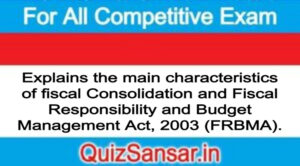
Explains the main characteristics of fiscal Consolidation and Fiscal Responsibility and Budget Management Act, 2003 (FRBMA).
Explains the main characteristics of fiscal Consolidation and Fiscal Responsibility and Budget Management Act, 2003 (FRBMA).
Ans.
The FRBM Act os a fosca; sector legislation enacted by the government of India in 2003, aiming to ensure fiscal discipline for the centre by setting targets including reduction of fiscal deficits and elimination of revenue deficit. It is a legal step to ensure fiscal discipline and fiscal consolidation in India.
The targets set under the Act was postponed several times in later years though some other goals of the Act including phasing out of government borrowing from the RBI were implemented.
Why FRBM became necessary ?
The FRBM Act was enacted in 2003 as rising government borrowing and the resultant government debts have seriously eroded the financial health of the government. High revenue deficit due to higher expenditure on subsidies, salaries, defence etc. compelled the government to make big borrowing from early 1990s onwards. With inadequate revenues, government resorted to high level of borrowing.
The borrowing again produced high interest payments. In this way, interest payments became the largest expenditure item of the government. To arrest this financial weakness in its budget, the government has taken some serious deficit cut targets by introducing a law in the form of the FRBM.
What the FRBM says?
The FRBM rule set a target reduction of fiscal deficit to 3% of the GDP by 2008-09. This will be realized with an annual reduction target of 0.3% of GDP per year by the Central government. Similarly, revenue deficit has to be reduced by 0.5% of the GDP per year with complete elimination by 2008-09. Later, the target dates were reset and budget 2016-17 aims to realise the 3% fiscal deficit target by March 2018.
The Act gives slight flexibility to the government regarding the realisation of the target as well. It gives the responsibility to the government to adhere to these targets. The Finance Minister has to explain the reasons and suggest corrective actions to be taken, in case of breach. Following are the provisions of the Act in detail.
(i) The government has to take appropriate measures to reduce the fiscal deficit and revenue deficit so as to eliminate revenue deficit by 2008-09 and thereafter, sizable revenue surplus has to be created.
(ii) Setting annual targets for reduction of fiscal deficit and revenue deficit, contingent liabilities and total liabilities.
(iii) The government shall end its borrowing from the RBI except for temporary advances.
(iv) The RBI not to subscribe to the primary issues of the central government securities after 2006.
(v) The revenue deficit and fiscal deficit may exceed the targets specified in the rules only on grounds of national security, calamity etc.
Though the Act aims to achieve deficit reductions prima facie, an important objective is to achieve inter-generational equity in fiscal management. This is because when there are high borrowings today, it should be repaid by the future generation. But the benefit from high expenditure and debt today goes to the present generation. Achieving FRBM targets thus ensures inter-generation equity by reducing the debt burden of the future generation.
Other objectives include: long run macroeconomic stability, better coordination between fiscal and monetary policy, and transparency in fiscal operation of the Government.
Amendments to the FRBM Act
Amendments to the Act were made after its initial version in 2003. This include revision of the target realisation year and introduction of the concept of effective revenue deficit. In 2012 and 2015, notable amendments were made. As per one provision of the amendment, a “Medium-term Expenditure Framework” statement should be prepared which will set a three-year rolling target for expenditure indicators.
As per the amendments in 2012, the Central Government has to take appropriate measures to reduce the fiscal deficit, revenue deficit and effective revenue deficit to eliminate the effective revenue deficit by the 31st March, 2015 and thereafter build up adequate effective revenue surplus and thereafter as may be prescribed by rules made by the Central Government.
As per Finance Act 2015, the target dates for achieving the prescribed rates of effective deficit and fiscal deficit (3% fiscal deficit) were further extended by 3 years to March 2018.
As per the 2017-18 budget, the government has extended the timeline for the achievement of the 3% target to 2018-19.
Committee to review FRBM targets
As per the Union Budget 2016-17, the government constituted a Committee to review the implementation of the FRBM Act. This was after a widely held view among experts that instead of fixed fiscal deficit targets, it may be better to have a fiscal deficit range as the target. This will help the government to meet specific situations like recessions which demand high government expenditure. There is also a suggestion that fiscal expansion or contraction should be aligned with credit contraction or expansion respectively, in the economy, while remaining committed to fiscal prudence and consolidation, Budget stated that a review of the FRBM Act is necessary in the context of the unce tainty and volatility in the global economy.






